王彤
1967年出生于吉林省通化市,现居住北京,《中国国家地理》杂志图片总监。
展览:
个展
2015 造城,全视摄影画廊,郑州
2013 再重现,谷仓当代影像馆,兰州
2012 造城,798 see+画廊,北京
2011 两个轮子,雷登特教堂,威格罗,意大利
2009 重现,全摄影画廊,上海
2006 痕迹,全摄影画廊,上海
2005 痕迹,东京画廊,东京,日本
2004 痕迹,798百年印象,北京
群展
2014 表演与想象:影像中国1911-2014,挪威斯坦万格美术馆,挪威
2012 再重现,全摄影画廊,上海
重现,百鹤高画廊,克诺克,比利时
魔法中国,Magda 画廊,巴黎,法国
自行车岁月,谷仓当代影像馆,兰州
痕迹-摄影师的摄影收藏展,798吾乐影像空间,北京
2011 造城,亚历山大摄影双年展,亚历山大,意大利
自行车岁月,798东磊画廊,北京
自行车岁月,成都国际影像艺术基地,成都,四川
2010 象乱:城市化进程中的中国当代影像特展,顺德,广东
广东主义,扉艺廊,广州,广东
广东主义,艺穗会,香港
中国寓言,北京
2009 混合与分享,798映画廊,北京
2008 看得见的风景,798映画廊,北京
中国当代摄影,DNJ画廊,洛杉矶,美国
中国制造,波兰罗兹国际摄影节,罗兹,波兰
2007 构建和谐社会,平遥国际摄影大展,平遥,山西
痕迹,China Photo,齐根,德国
构建和谐社会,全摄影画廊,上海
痕迹,荷兰国际摄影节,格罗尼根,荷兰
2006 痕迹,韩国摄影博物馆,东江,韩国
2005 集体空间,香港视觉艺术中心,香港
都是我,米兰画廊,米兰,意大利
2004 都是我,北京东京艺术工程,北京
2003 电视多动症,北京
都是我,平遥国际摄影节,山西,平遥
出版
2105 《造城》个人摄影集
2013 《重现》个人摄影集
2006 《MAO ON THE WALL》个人摄影集
2003 《时代映像—王彤》个人摄影集
正是因为这种视线的连接,《造城》才区别于时下的景观摄影。它不是一种格式化的词语,也不呈现为类型学的样式,它是一种碎片化的、多视点的。在某种意义上,我们可以将这三组作品当作一个传统纪实转向观念、转向景观摄影的过渡性个案。
王彤在上世纪九十年代中期开始拍摄《痕迹》的时候,还是个刚接触摄影不久的艺术青年。对于那些残留在墙垣上的年代,他是这样描述的:“我出生在文革开始的第二年,1967年。童年是在粮食要粮票、猪肉要肉票中度过的。在各种物资极度匮乏的那个时候,我最大的梦想就是能够过瘾地吃上一顿肉!不过,有趣的是,回忆起漫长的童年,其实还是在欢乐和幸福当中度过的!”王彤其实没有真正经历文革,那个年代所发生的一切,并没有给他带来触及灵魂的切肤之感,带给他的反而是自由撒欢的童年(大人们闹革命去了,无暇顾及孩子)。王彤是作为一个孩子观看成人世界的闹剧。那些外在于一个孩子内心的社会场景虽然没有具体的意义,仍然深刻地印在了他的脑子里。也许正因如此,反而使成长后的王彤有了一个与历史保持相对距离的姿态。我猜测最初让王彤产生兴趣的不是那些标语和领袖画像所代表的时代情景,而是断壁墙垣上那些在时光流逝中形成的视觉美感。正是这样一种状态,使王彤的“痕迹”没有痛感,反倒显现出一种残缺的优美:在时间无情的消蚀中,一个狂暴与充满伤痛的时代归于寂静,呈现为一种视觉景观。我想,王彤是在长久地关注这些历史印迹的过程中,补上了他未曾经历过的历史课程,进而从最初的视觉愉悦转化为自觉的具有历史感的文献记录。如果不是这种转变,没法解释王彤二十多年不变的执著。著名的评论家顾铮对王彤的这组作品评价道:“为拍摄这些记录了一个时代的疯狂、忠诚与激情的革命“圣像”,王彤细细踏勘,留心记录,集腋成裘,经年累月地积累下来,形成一定规模,并最终成为一个具有数量保证的打上了鲜明时代印记的文献性视觉记录。”《痕迹》在保留历史记忆的同时,也给王彤打开了一个走向历史深处缝隙的空间,使他的摄影有了一个更为自觉的历史维度,他从此开始在历史与现实交错中探寻……
第二组作品《重现》是王彤在探寻历史与现实的交错中推进的一大步。王彤抛弃了纪实的摄影方式,用行为艺术与摄影共同形成了他对历史与现实关系的探究。我们可以把这组作品视为《痕迹》的升级版。在这组作品中,王彤按照历史经典影像的领袖造型扮演毛泽东,并严格地在领袖曾经出现的历史现场摆出经典姿式,留影!有意思的是历史现场不再,作为烘托伟大领袖的背景已然“换了人间”,并且景别变化:环境大了,领袖小了。这些被制造的历史与现实共存的图景,表达了存在于不同历史情景中的被控制的现场的双重困境与荒诞。同时,由于作者个人身体的加入,“这‘扮演’与‘表演’本身就是一种对历史的继续。”(顾铮)从墙上的领袖到扮演领袖,王彤本人也经历了一种消散建构,建构消散的过程。他从历史建造的现场,感受历史无情的被消散。他又以个人之力试图在消散历史的现场中重现历史。这种荒诞的轮回是一个非常重要的过程,王彤在这个过程中,成为对于现实怀抱清醒态度的摄影者。
王彤曾经提到创作《重现》的动机是源于城市空间对于人的控制与压迫。这意味着,王彤对于消费社会的空间景观早已有所感受。正是这种感受,生发出一种历史与现实交错的线索。除此之处,我们还可以将《重现》的源头追溯到王彤的第一组作品《痕迹》。王彤从现实的压力中鱼跃似地跳向历史,发出疑问:一个由政治理想带领的改朝换代,一个由物质欲望带动的改天换地之间,究竟有着什么样的关联?为什么我们从美好的理想出发,最终仍是走到了自己愿望的反面?
在《造城》中,王彤继续着他的质疑。以《造城》之名,王彤集结了他十几年来对中国城市发展持续关注的成果,直接地发出了批判的声音。《造城》描述了中国时下轰轰烈烈的城市再造图景。新城老城大城小城,都在以“造城”的方式改变着我们的生活。他的《造城》,呈现了权利空间、传播空间、商业空间,欲望空间、暴力空间……宏观到微观景观。在拍摄时间上,从上世纪90年代末一直持续到当下。这些长久的、多视点的、随机的、碎片化的图景,记录了造城之城的样貌。
景观摄影在进入21世纪以来,成为当代艺术一股强力的、冷峻的、多向度的具有深刻批判力的艺术思潮。艺术家们在现实严酷的包围之中,不得不面对,不得不表达,不得不从对人的主体性关注,转向对于非人化的物化世界的呈现。现实太强大了!这个强大的现实所体现的权欲与物欲的合谋,以有史以来最为蛮横的面貌,矗立在公众面前。我们在一种无形的控制之下逐渐趋向木然痛感窒息,我们在这浮华繁荣的世界,只能紧缩我们冰冷僵硬的身体。
“在现代生产条件无所不在的社会里,生活本身展现为景观(spectacles)的庞大堆聚。直接存在的一切全都转化为一个表象(representation)。”这是居伊·恩斯特·德波对资本主义社会图景最为著名的论断。这个论断用来概括我们时下的社会不也深刻而准确吗?我们不也正处于这样的“景观的世纪”(德波)中吗?当景观——“一种更深层的无形控制”(德波)控制了我们,我们丧失生命与精神的灵动而无所适从。我们被城市空间的建筑巨无霸控制,我们被媒体的喧嚣控制,我们被引向越来越表象越来越单薄的生活,并且在这种表象化的生活中,心灵不再敏感细腻。物化与政治化一样再次捆绑了我们。城市不断地被建造出来,城市不断地在建造中消失……与此相应,人的在场不断地被制造出来,又不断地被消解……在这场少数人控制的游戏中,沉默的大多数被尘埃化——这就是王彤在《造城》中力图要向我们呈现的事实。“可怕”,是王彤在给我看他作品时常说的一句话。感到“可怕”的岂止是王彤一个人?这末世般惶恐的景象:暴力、荒诞、诡异、沉寂、虚幻,既近又远,既实又虚,透出一股“死城”的味道——光怪陆离繁华富丽中的最后探戈!
王彤的《造城》没有采取景观摄影通常选择的格式化句式以及彩色摄影,也不体现为“无表情外观”。他选择了传统的黑白影调以及“有表情”的叙述。《造城》不是事先构思好再进行工作的结果,这种状态与他的《痕迹》相似。他的这种方式正好与摄影的本质相契合。摄影就是这样一种在面对现实的观察中,不断与时间博弈的方式。正是这样一种认知方式指引着摄影家在积累中不断去触探存在的深层。我尊重这种积累,因为,在当下有太多存在策略嫌疑的东西。我感谢王彤带给我们这种具有时间长度的积累,提示我们在当下平面化的生存中警惕遗忘。就图像的表达而言,多视点和黑白影调叙事,也许正好表达了作者与传统建立某种联系的愿望,同时与景观社会的日愈表象化、虚无化也许适合。
王彤在十几年时间跑遍中国各地,将千城一面的“造城”运动记录在案。当今中国,几乎每个城市都是一个工地,此起彼伏。几乎所有的城市都在重新建设,几乎所有的城市外观都似乎被一双无形之手化归一式。历史文化形成的城市差异被抹去了,地理差异被抹去了,生活习性与文化特性被抹去了。大到一线城市,小到边远县城,千城一面成为当代中国空间景观的又一大特色。在城市化进程日益剧烈的今天,除却媒体信息景观,城市景观的日新月异直接刺激与迫使我们感受世界变化。这种变化以一种不易察觉却翻天覆地的执着正将我们带入一种统一的城市景观丛林,并最终影响着我们关于城市的认知经验日益趋同。统一景观与认知经验同化的互文,意味着城市景观的复制与认知经验的复刻。这种趋同中消逝的又何止是空间外观的差异?于是,正如我们所经验到的那样,从某一处城市景观辨别某一个城市变得越来越困难重重。
“造城”,从语词上解读无疑是与建构有关。这种建构至少是一种两面体,一面是现实城市的建构;一面是人的城市经验建构。同时,基于世界与人多向度的对流、冲撞、印刻,“造城”之“建构”在完成和完整的意义之下又始终指向一种消散的过程。《造城》系列给我们提供了这样一种直观:建构与消散、完成与过程……用瞬间凝定对抗暧昧不明的经验意义。值得提示的是,王彤以他敏锐而富于细节性的观察呈现了现实与历史暧昧交错中那一条隐藏着的牢固而紧密的精神牵连。
德波说景观是一种隐形的意识形态,在王彤的《造城》中,我们感受真切。
Forging Cities look directly at reality, moving away from twining between the history and reality. His trio of works resembles a syllogistic narrative, thus Forging Cities and Mao on the Wall can be seen in the context of Reenactment. While some photographs in the Forging Cities series were taken before Reenactment, I would say that Reenactment came into existence exactly because of feelings gathered by the artist as he viewed the spectacle of city spaces. So we can say that Reenactment and Forging Cities inspired each other.
If Wang Tong had not developed a sense of historical depth during his shooting of Mao on the Wall and Reenactment, he could not have produced Forging Cities. Here Wang stopped his internal debates to voice unambiguously his opinions toward the reality around him.
This work differentiates itself from other current spectacle photography due to the conjunctions between its lines of sight. It is not a typological work, but rather is fragmented and looks at the subjects from many viewpoints. We can regard this trio of books as a transition from a more traditional on - the - spot record to conceptual and spectacle photography.
Wang was a young artist who had just started to take photographs when he began shooting the series of Mao on the Wall in the 1990s. He described an era that lingered on broken walls: “I was born in 1967, the second year of the Cultural Revolution. In my childhood people had to show ration coupons to buy grains and meat. In those years of extreme poverty, my paramount dream was to enjoy a big meal with meat! However, surprisingly, when I recall my childhood, I feel in fact that I spent it in happiness and joy.” Actually Wang did not truly experience the Cultural Revolution. The events that took place in those years did not mark his soul. On the contrary, the chaos gave him a childhood full of freedom and happiness, adults were too busy participating in revolution to find time to care for their children. As a child, Wang was an onlooker to the farce in the world of adults. Those scenes of upheaval, despite leaving no concrete meaning in the heart of a child, left a deep mark in his mind. Perhaps this is the explanation for the distance between the adult Wang and history. My guess is that the original interest in shooting these photos was not the historical scenes represented by the slogans and the portraits of Mao, but the visual aesthetic feeling formed on those ruined walls with the lapse of time.
Under such circumstances, Wang’s Mao on the Wall brings us no pain, but rather it manifests beauty through its incompleteness: with the ruthless passage of time, an era filled with violence and suffering ended in silence, transformed into a visual spectacle. I believe that Wang made up for the history class that he missed by focusing on these traces of history. His works evolved from visual pleasure to a documentary with a sense of history. Otherwise, we can find no reason for his dedication over more than 20 years. The well - known critic Gu Zheng commented thus on this series: “To shoot the revolutionary ‘sacred portraits’ that record the madness, loyalty and enthusiasm of an era, Wang Tong travelled far and gathered his material carefully. Many a little makes a mickle. The accumulation of many years finally reached a scale that became a visual documentary record with vivid imprints of the times.” Mao on the Wall not only preserves historical memories, but opens a space for Wang to walk into the depths of history, enabling his photography to attain a self - conscious historical dimension. From here he began to explore the links between history and reality.
The second series of works, Reenactment, is a stride for Wang in his search in the crisscross between history and the present. Wang abandoned documentary photography, deployed performance art and photography together to carry out his exploration into the relations between history and the present. We can regard this series as an evolution from upgraded Mao on the Wall. Wang dressed like Mao Zedong in the classic image of the “Great Leader”, and posed in a signature gesture at places that Mao visited. Snap! Each is no longer a historical site; the background against which Mao once stood prominent is entirely different. In the pictures, another change is that the background is enlarged while the image of the Great Leader is shrunk. The co - existence of history and present created by Wang in these pictures expresses a dual predicament and the absurdity of the controlled scenes in a different historical context. And, due to the physical involvement of the photographer himself, “the ‘show’ and ‘perform’ is in itself an extension of history” (Gu Zheng). From looking at the ladder on the wall to performing the leader, Wang went through a process of dissolving structure, and then structuring the dissolved. He felt the merciless dissolution of history of the sites where history was made. He was trying to reproduce history, in person, on sites where history was already gone. The recycling of absurdity is an important process during which Wang becomes a photographer with a more sober attitude toward the reality.
Wang Tong once mentioned that Reenactment is the brainchild of the control and compression of human beings in the city space. He had long ago developed a sense of the spatial landscape of the consumer society. It is these feelings that inspired an idea of alternate history and the present. We can also trace the origin of Reenactment to Wang’s first series, Mao on the Wall. He dived towards history under the pressure of reality and asked: what is the link between an era dominated by political ideals and a world motivated by material desire? Why do we set off with glorious ideals only to end up with their opposite?
Wang continues his quest with Forging Cities. Here he voiced criticism directly through his concern over the development of Chinese cities in the past decade and more. Forging Cities describes the recreation of Chinese cities that is now so vigorous. Old, new, big, small, cities are changing our lives. This series displays both the micro and macro space of power, transmission, commerce, desire and violence. The photographs span an era from the end of the 1990s to the present. These photos, taken over time, from many viewpoints, random and fragmented, form a record of cities as they are forged into existence.
Spectacle photography has become a strong, stern and multi - dimensional trend in 21st century art. Wrapped in a rigorous reality, artists must confront,express, and move to showing the dehumanized material world and away from a focusing on the human being as an entity. The reality is powerful. The conspiracy between the desire for power and for the material appears before the public in the most arbitrary of images. We become more and more numb and suffocated under an invisible control. We can only withdraw our cold and stiff bodies from this “Vanity Fair”.
“In societies where modern conditions of production prevail, all of life presents itself as an immense accumulation of spectacles. Everything that was directly lived has moved away into a representation.” This is the most well - known judgment of capitalist social spectacle by Guy Ernest Dobord. Isn’t this judgment also precise and profound in summarizing our current society? Are we not also living in a “century of spectacles”? When spectacles, “a higher level of invisible control” , control us, we don’t know how to make choices because we lose our spirit. We are controlled by the huge constructions in cities, by the noise in the media, we are guided towards a more and more shallow and superficial life and our hearts are no longer tender and subtle. Materialism kidnaps us, just like politics. Cities are built continuously, cities disappear during the construction... Accordingly, people, too, are created and disappear. In a game controlled by the minority, the silent majority is as dust, a fact that Wang tries to show to us in Forging cities. “Horrible” is the word Wang often used when he showed his works to me. He is not alone in feeling the horror. These are doomsday scenes: violent, absurd, mysterious, dreary and shadowy. They are close yet far away, they are true yet false. They smell of the atmosphere of a dead city, the last tango of the big flourishing bazaar!
Wang’s Forging Cities do not use the formative expression that spectacle photography often adopts, nor does he use colored shots. He also abandoned the “expressionless appearance”. He chose traditional black - and - white tones and an "expressive" narration. Forging Cities is not the fruit of a design, just like his Mao on the Wall. This method corresponds to the essence of photography. Photography is a way to play constantly with the time through observing the reality.
The photographer is led thus to touch continuously the depth of existence through his accumulated experience. I respect this kind of accumulation, because too much these days appears “arranged”. I thank Wang for bringing us the accumulation of time, reminding us not to forget the past in our current flat life. As for the pictures, the multi - vision and black - and - white tone might properly express the author’s wish to establish a relationship with tradition. It also fits appropriately with the growing shallowness of a spectacle society.
Wang recorded the “Forging Cities” campaign that turns all the cities in China into the same one over the past decade. He travelled to every corner of the country, where almost every city is a construction site. Nearly all cities are experiencing a new spasm of construction, and their exterior fit a single mold, as if an invisible hand is erasing their differences in history, culture, geography and customs. From metropolises to remote townships, it has become a “Chinese characteristic” that all cities look alike. Does this reflect the light of China’s "all - in - one" tradition? Urbanization is spreading like wildfire, the changes in our cities as well as the onslaught of media information directly stimulates us, and force us, to feel the changes in the world. These changes, subtle but persistent, are guiding us into an identical urban landscape everywhere, and eventually converge our experience of living in such cities. The interaction between the urban landscape and people’s urban living experiences, means that in the duplication of the urban landscape we lose more than just the exterior difference between the cities. Just as we have already observed, it is becoming increasingly difficult to distinguish one city from another.
“Forging Cities”, literally, does doubtlessly involve construction. But the construction has at least two aspects, one is the construction of cities, the other of people’s experience in cities. Meanwhile, based on the multi - dimensional exchanges and clashes between the world and humans, “forging” and “construction” have always signaled a process of disappearance. The series “Forging Cities” provides us with such a viewing experience: construction and dispersal, completion and progress... The instant image confronts ambiguous empiricism. What is worth mentioning is that, with his exquisite and detailed observation, Wang shows us the spiritual link, solid and tight, with reality and history.
Spectacle is an invisible ideology, according to Dobord. We see his point with the utmost clarity in Wang’s “Forging Cities”.
1967年出生于吉林省通化市,现居住北京,《中国国家地理》杂志图片总监。
展览:
个展
2015 造城,全视摄影画廊,郑州
2013 再重现,谷仓当代影像馆,兰州
2012 造城,798 see+画廊,北京
2011 两个轮子,雷登特教堂,威格罗,意大利
2009 重现,全摄影画廊,上海
2006 痕迹,全摄影画廊,上海
2005 痕迹,东京画廊,东京,日本
2004 痕迹,798百年印象,北京
群展
2014 表演与想象:影像中国1911-2014,挪威斯坦万格美术馆,挪威
2012 再重现,全摄影画廊,上海
重现,百鹤高画廊,克诺克,比利时
魔法中国,Magda 画廊,巴黎,法国
自行车岁月,谷仓当代影像馆,兰州
痕迹-摄影师的摄影收藏展,798吾乐影像空间,北京
2011 造城,亚历山大摄影双年展,亚历山大,意大利
自行车岁月,798东磊画廊,北京
自行车岁月,成都国际影像艺术基地,成都,四川
2010 象乱:城市化进程中的中国当代影像特展,顺德,广东
广东主义,扉艺廊,广州,广东
广东主义,艺穗会,香港
中国寓言,北京
2009 混合与分享,798映画廊,北京
2008 看得见的风景,798映画廊,北京
中国当代摄影,DNJ画廊,洛杉矶,美国
中国制造,波兰罗兹国际摄影节,罗兹,波兰
2007 构建和谐社会,平遥国际摄影大展,平遥,山西
痕迹,China Photo,齐根,德国
构建和谐社会,全摄影画廊,上海
痕迹,荷兰国际摄影节,格罗尼根,荷兰
2006 痕迹,韩国摄影博物馆,东江,韩国
2005 集体空间,香港视觉艺术中心,香港
都是我,米兰画廊,米兰,意大利
2004 都是我,北京东京艺术工程,北京
2003 电视多动症,北京
都是我,平遥国际摄影节,山西,平遥
出版
2105 《造城》个人摄影集
2013 《重现》个人摄影集
2006 《MAO ON THE WALL》个人摄影集
2003 《时代映像—王彤》个人摄影集
Wang Tong Resume
1967Born in Tonghua, Jilin Province, China
Live in Beijing
Solo Exhibitions
2015 “Forging cities”,PAN-VIEW Gallery, Zhengzhou, China,
2013 “RE-Reenactment” ,Gucang contemporary photo Gallery, Gansu,China,
2012 “Forging cities”, 798 see+ art space Gallery, Beijing, China
2011 “Su due ruote" (On two wheels), Ex Chiesetta del Redentore, Vigolo Vattaro (TN), Italy
2009 “Reenactment”, OFOTO Gallery Shanghai, China,
2006 “Mao on the wall”, OFOTO Gallery Shanghai, China,
2005 “Mao on the wall” ,Tokyo Gallery, Tokyo, Japan,
2004 “Mao on the wall” ,798 Photo Gallery, Beijing, China,
Selected Group Exhibitions
2014 “Performance and Imagination: Chinese Photography 1911-2014”, Stavanger Art Museum, Norway,
2012 “RE-Reenactment”, OFOTO Gallery Shanghai, China,
“Reenactment”, Berko Fine Painting Gallery, Knokke, Belgium,
“Magic Chinat”, Magda Danysz Gallery, Paris France,
“Bicycle Kingdom”,Gucang contemporary photo Gallery, Gansu, China,
2011 “Forging cities”, Biennale di Alessandria, Alessandria, Italy,
“Bicycle Kingdom”, Me Photo Art Gallery, Beijing, China,
“Bicycle Kingdom”, Chengdu International Photography Center, Chengdu, China,
2010 “Cantonism”, Hong Kong,
“Cantonism”, Fei Gallery, Guangdong, China,
“Disorder: China Contemporary Photography Exhibition in the progress of urbanization”, Guangdong, China,
“China Fables”, Beijing,China
2009 “Remix and Share”, INTER Art Center & Gallery, Beijing, China,
2008 “Contemporary Photography from China” ,DNJ Gallery,
“Mao on the wall”, INTER Art Center & Gallery, Beijing, China,
“MADE IN CHINA - Chinese photography”, Fotofestiwal – Poland,Lodz, Poland,
2007 “Build a harmonious society”, Pingyao International Photography Festival, Shanxi, China,
“Mao on the wall” ,China Photo, Siegen, Germany,
“Build an harmonious society” ,OFOTO Gallery, Shanghai, China,
“Mao on the wall” ,Fotografie Noorderlicht, Groningen, Noorderlicht,
2006 “Mao on the wall” ,Museum of Photography, Dong-gang, Korea,
2005 “Collective space” HK Visual Arts Ctr, Hong Kong
“ It is I” , Galleria Carla Sozzani, Milan, Italy,
2004 “ It is I” ,798 Art Gallery, Beijing, China,
2003 “ It is I” ,Pingyao International Photography Festival, Shanxi, China,
Publications
2105 “Forging cities”, China
2013 “Reenactment”, Hong Kong
2006 “Mao on the wall”, Hong Kong
2003 “Era’s Image: Wang Tong”, China
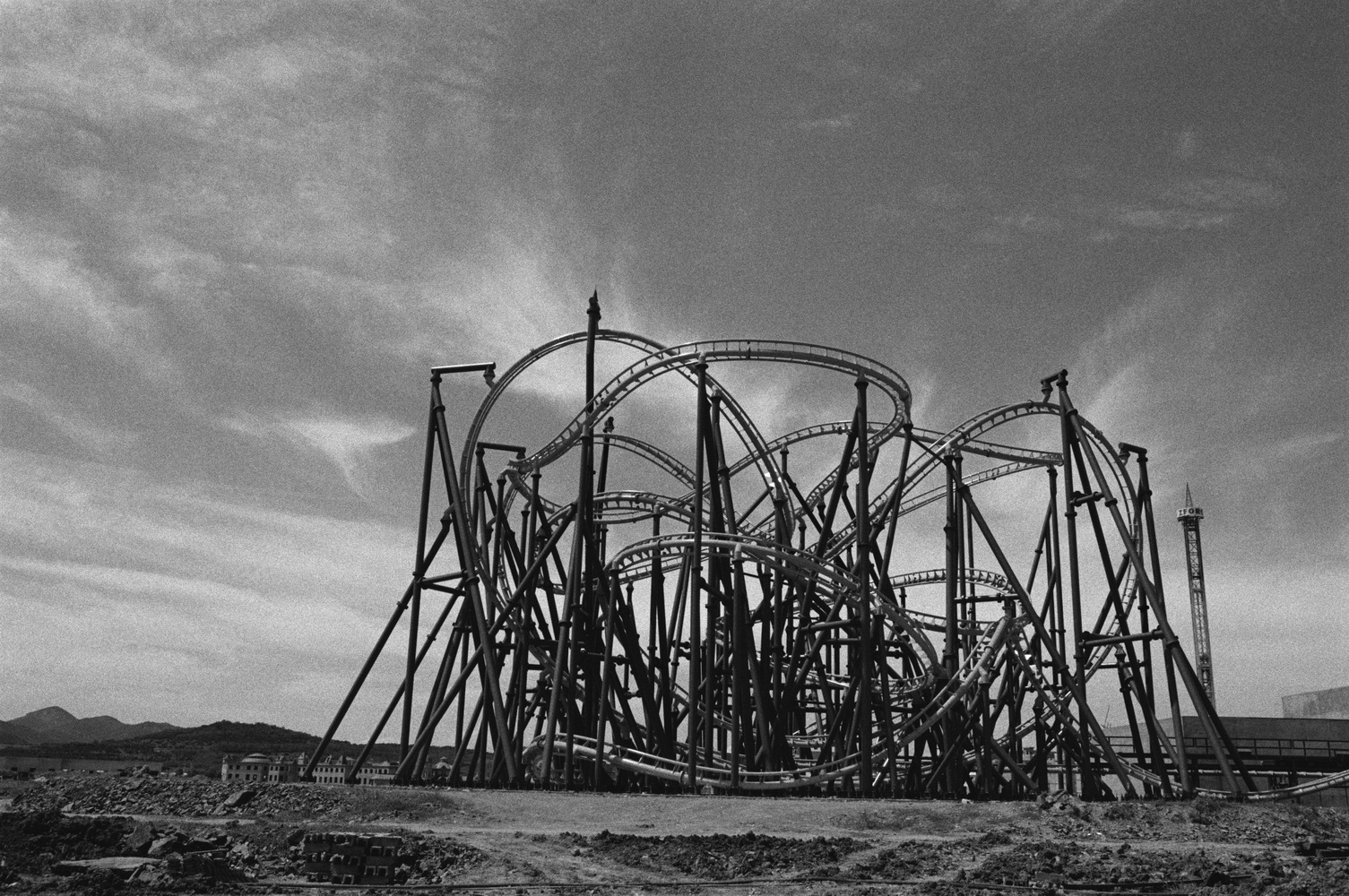
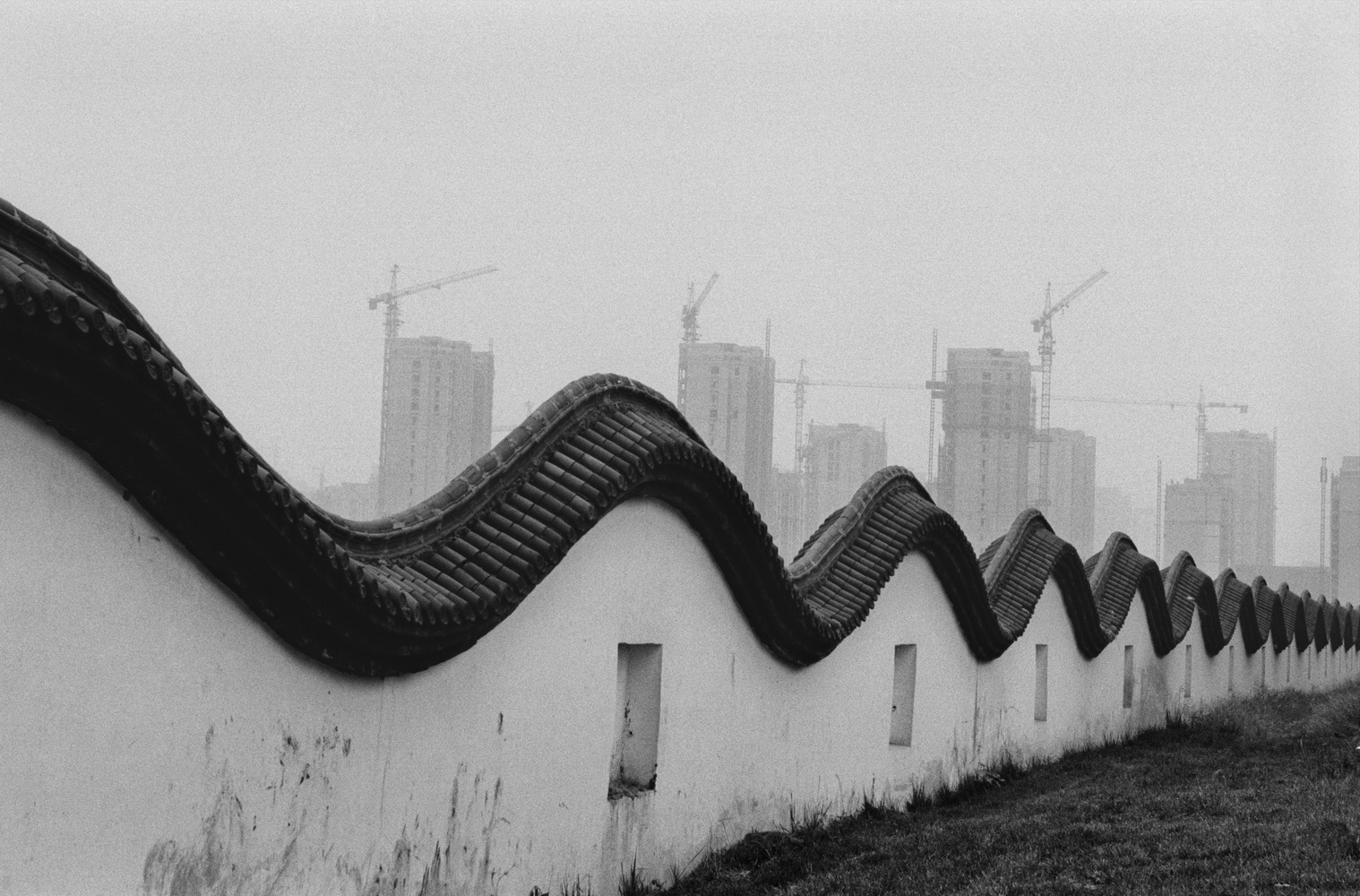
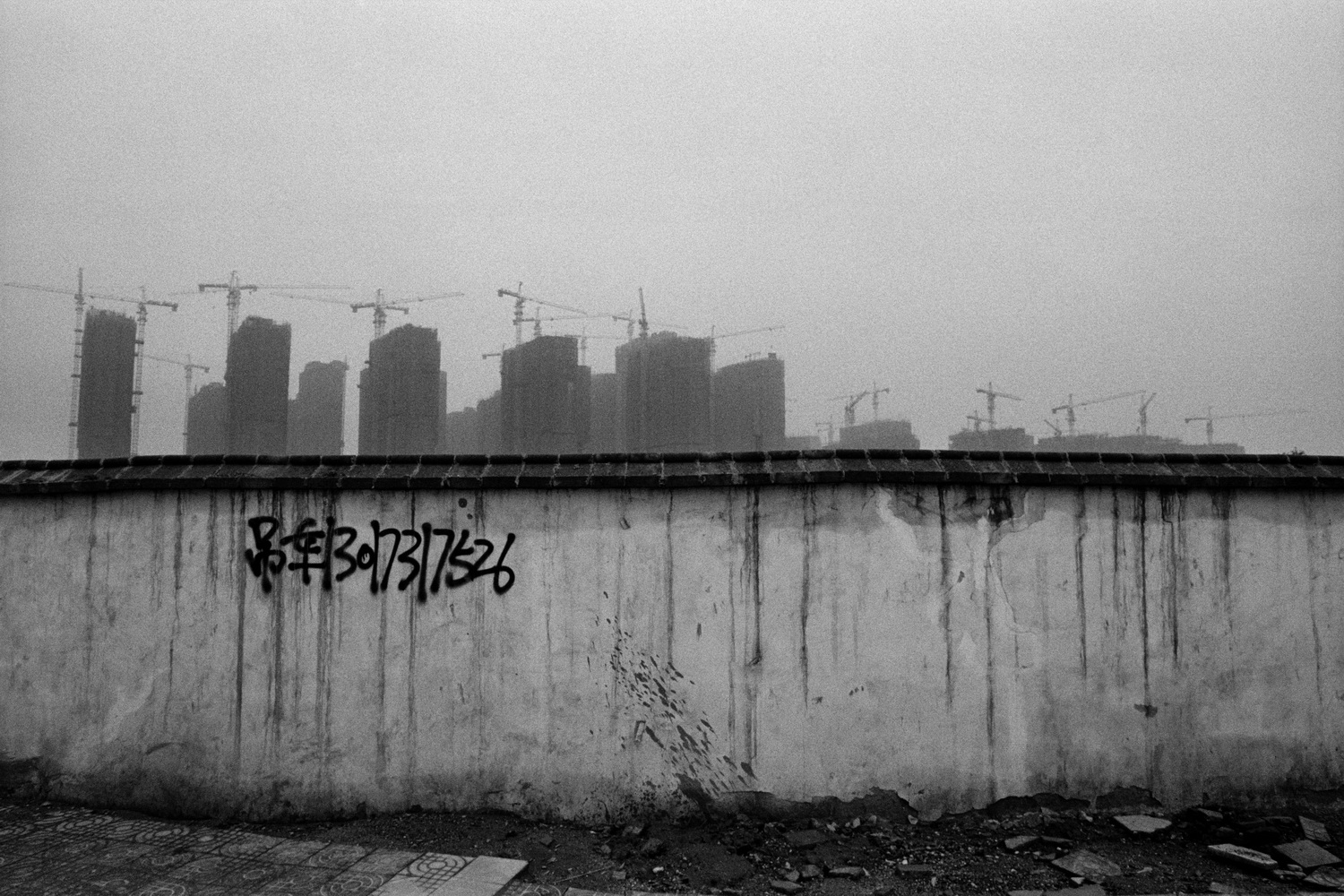
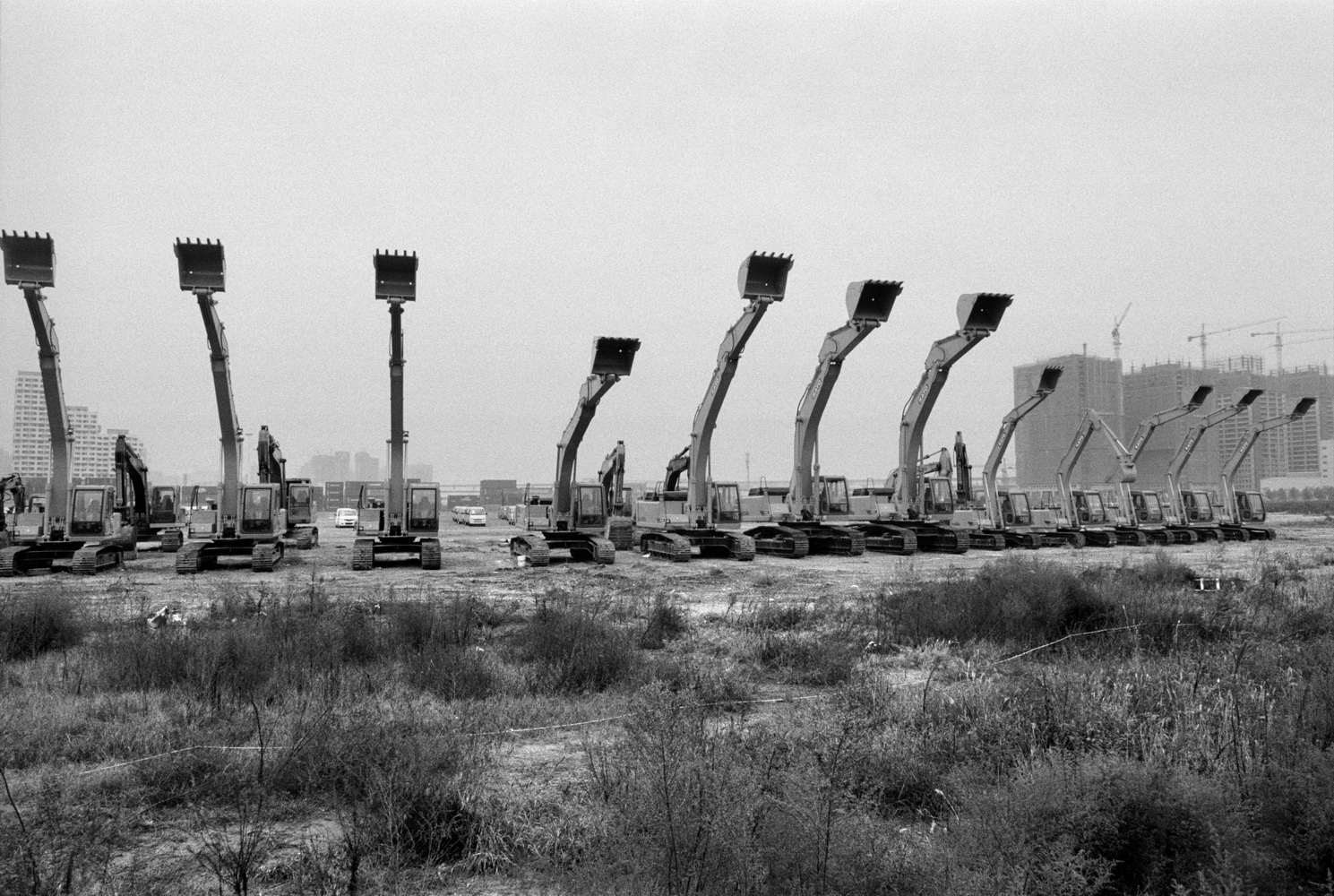
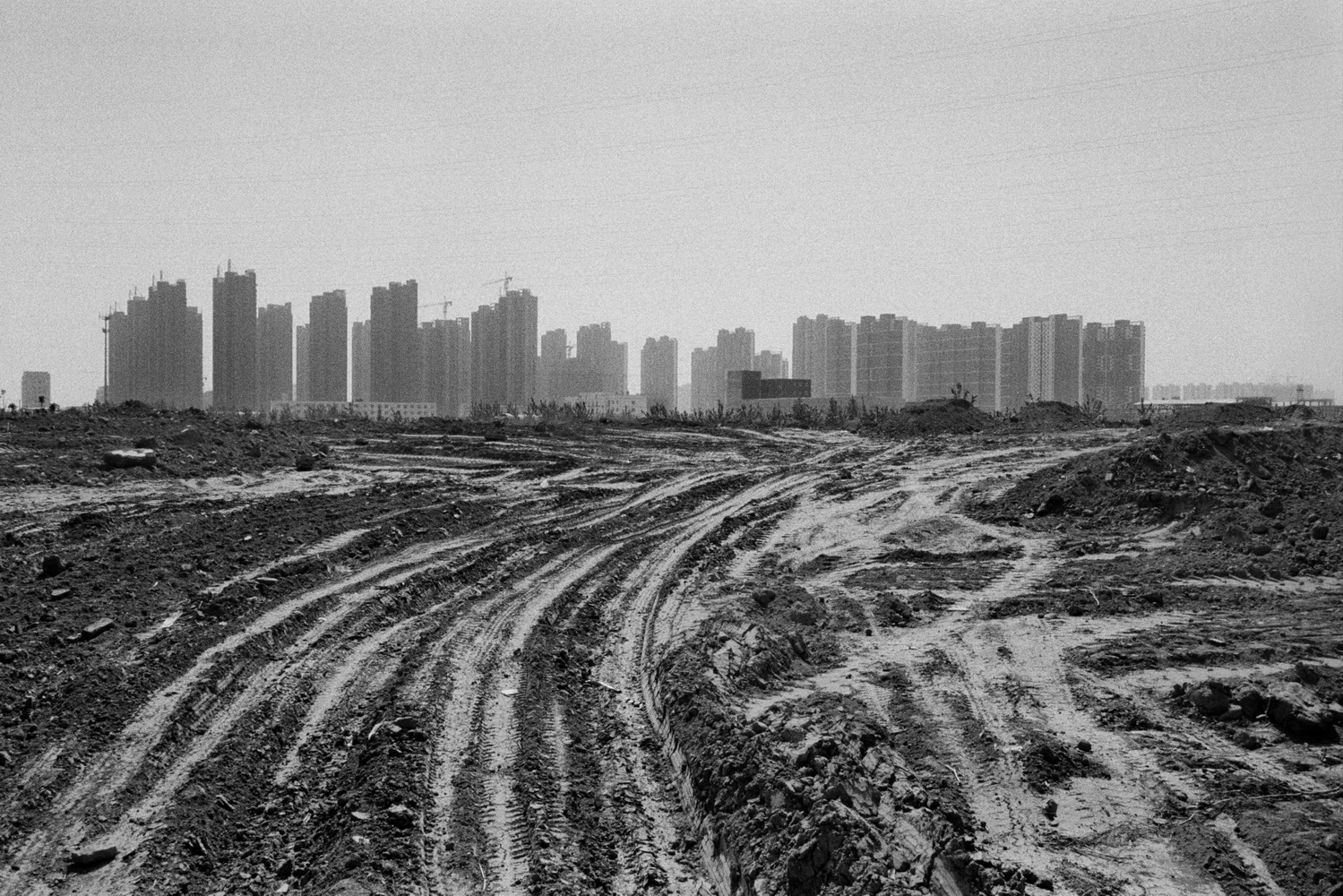
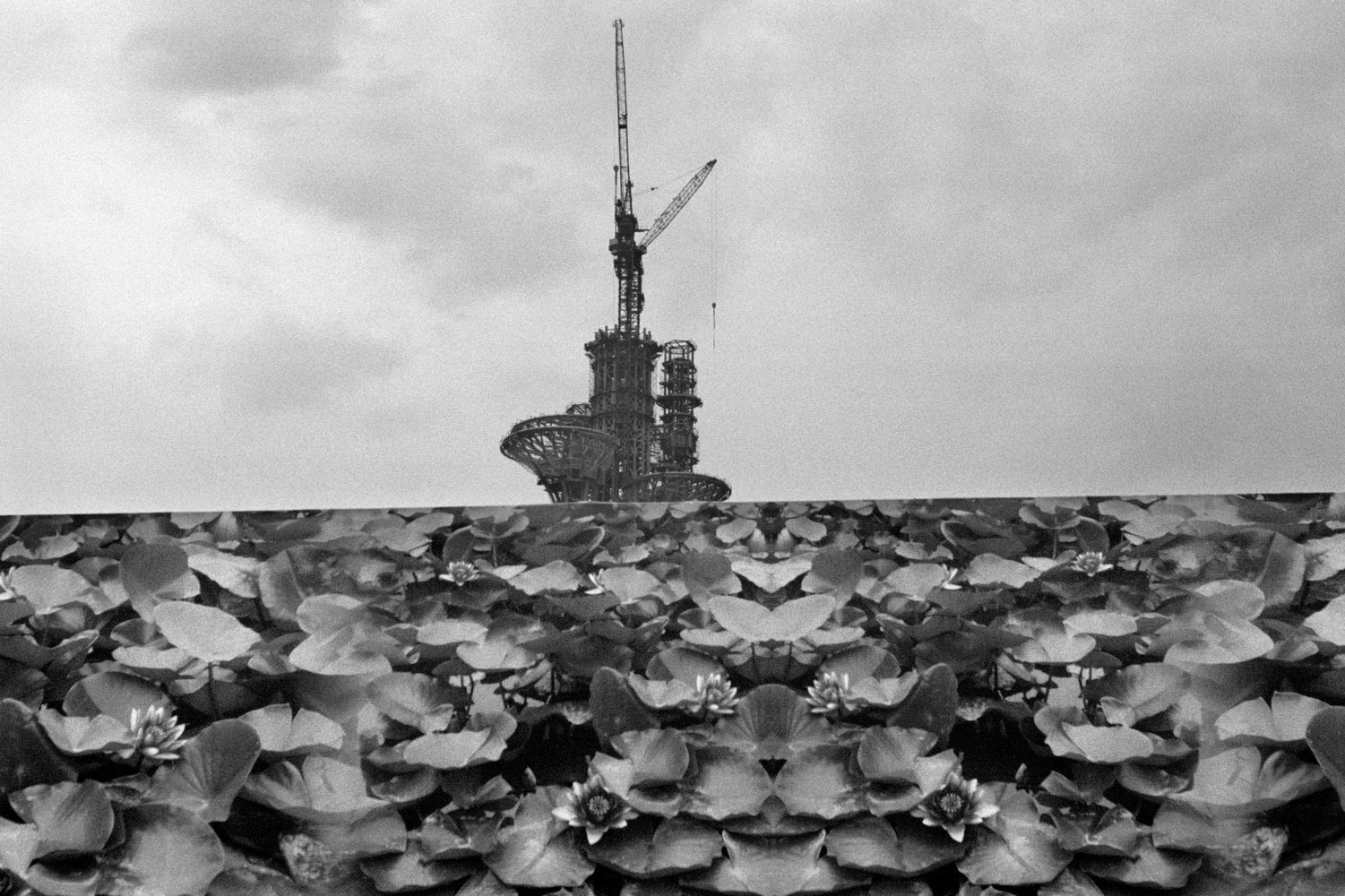
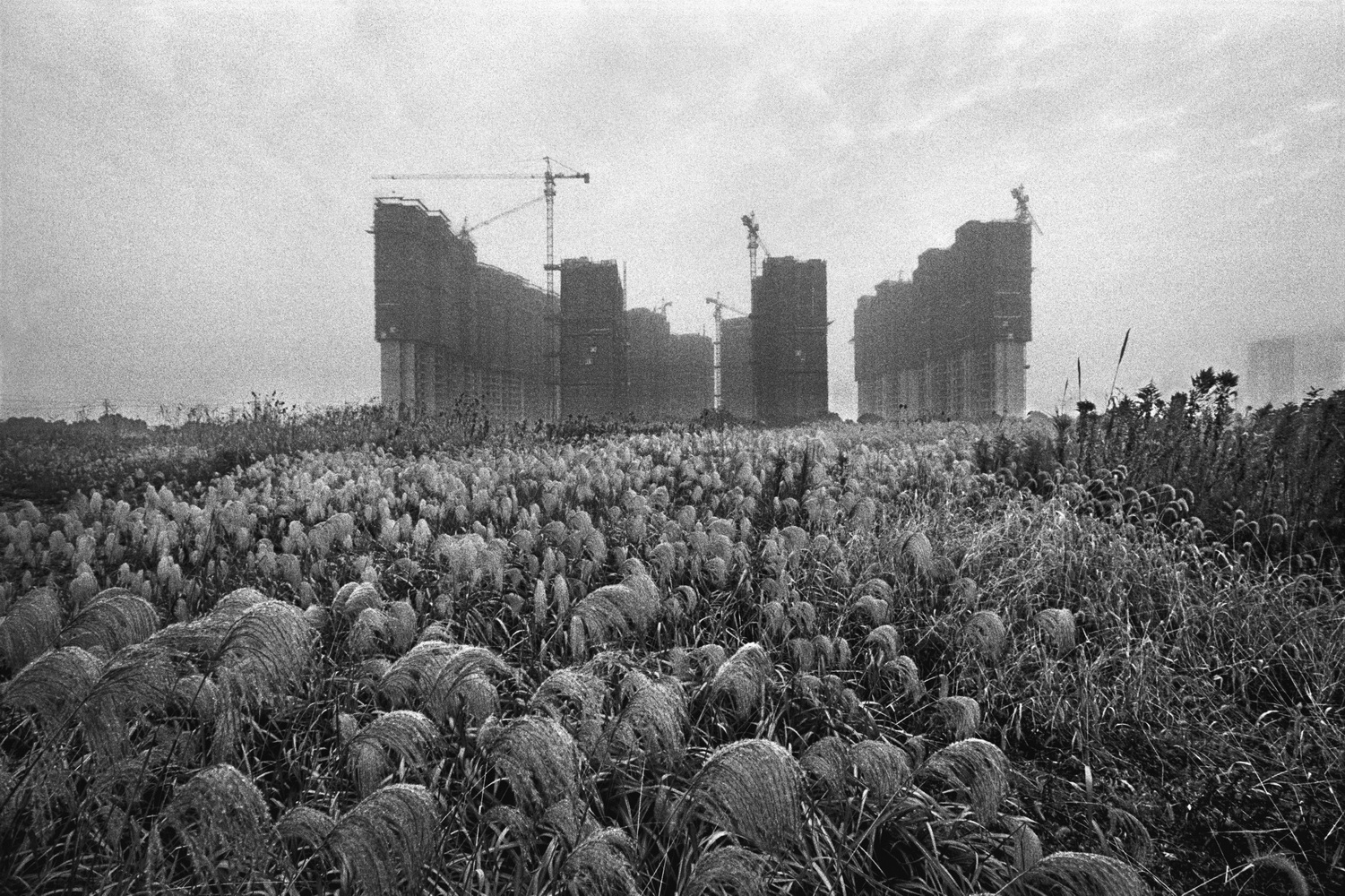
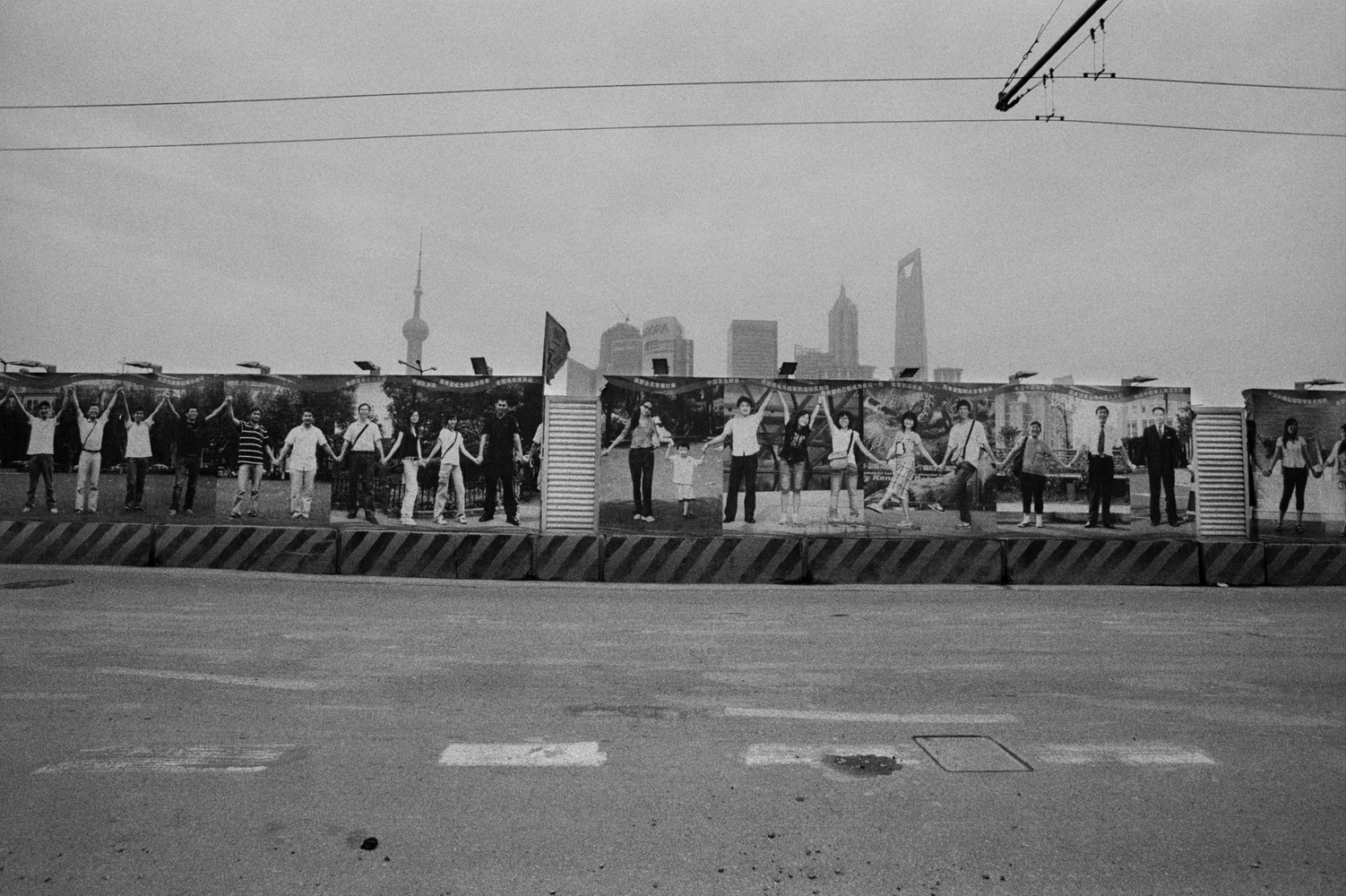
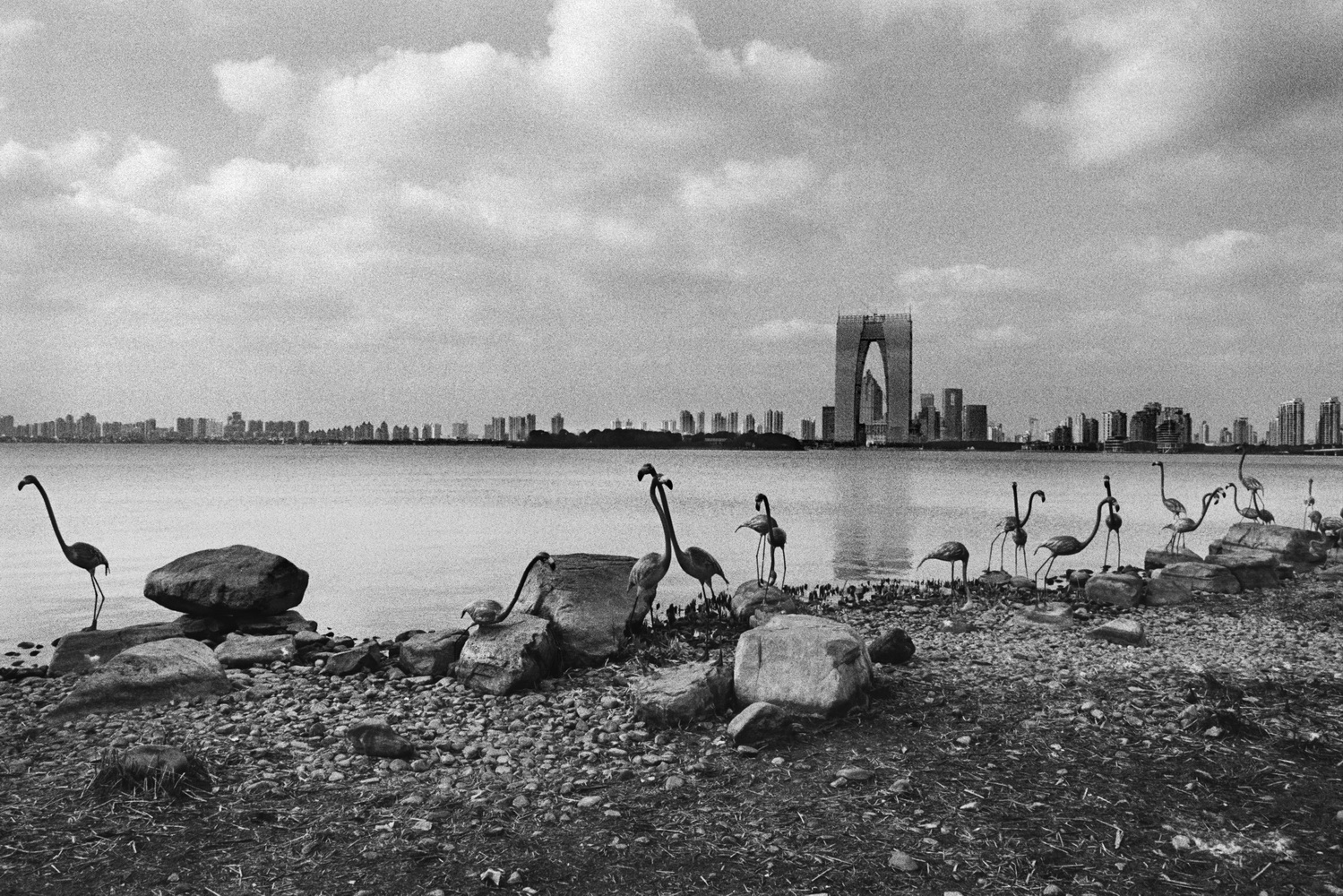
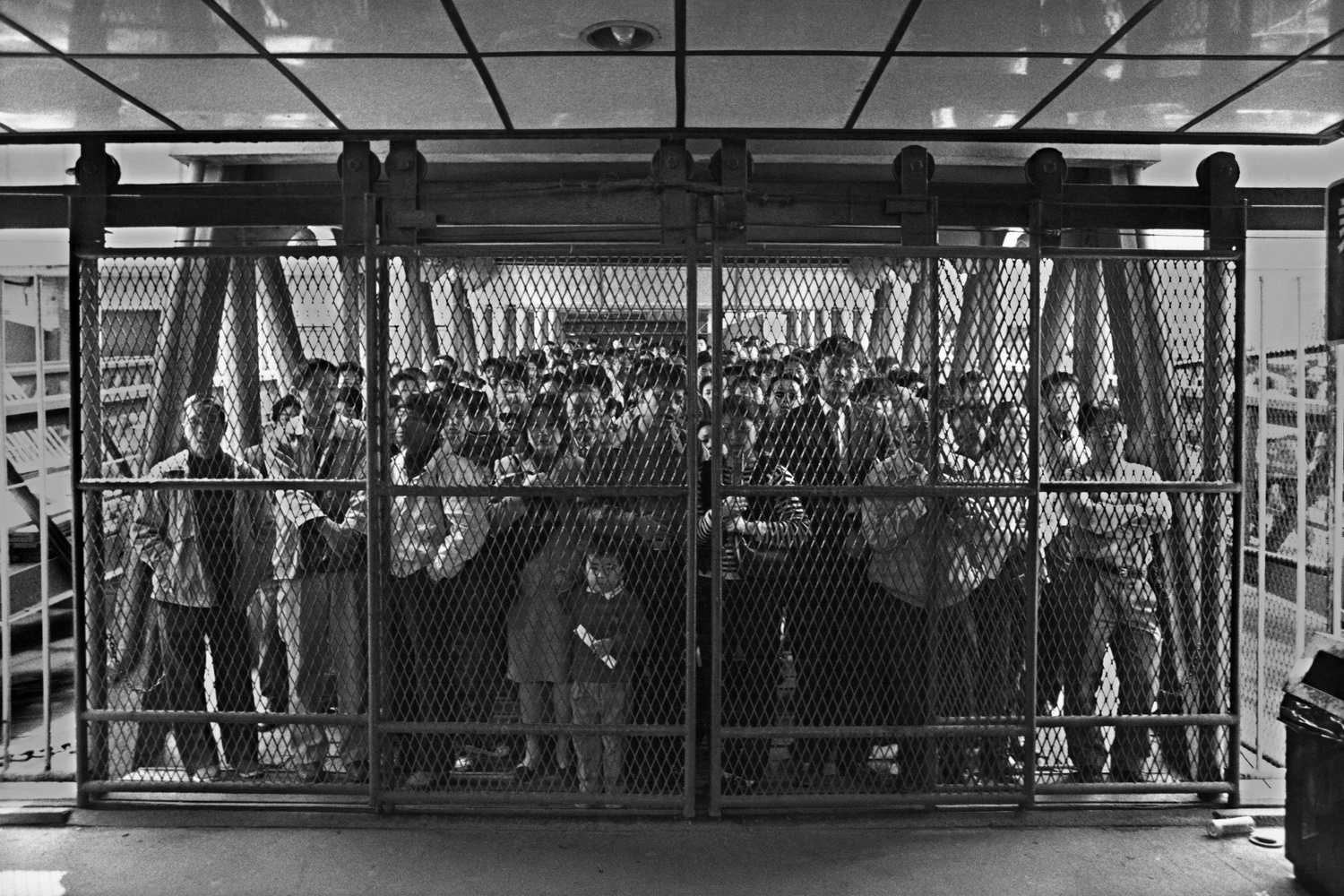










造城之城
李媚
继《痕迹》、《重现》之后,王彤从他十多年的积累中,整理出了他的《造城》系列。《造城》没有直接涉入历史与现实的纠葛,而是完全指向现实。王彤的三组作品似乎有一种三段式的叙事,可以把《痕迹》和《造城》看作是《重现》的上下文。虽然从时间的排序来看,《造城》的部分作品拍摄于《重现》之前,从某种意义上说,正是因为有了对于城市空间景观的感受,才有了《重现》。这使得《重现》和《造城》之间有一种互为刺激的生发。正因为王彤在《痕迹》、《重现》的拍摄中,形成了一种具有历史纵深感的态度,才会将这些城市时空的碎片结构成为现在的《造城》。王彤不再纠结,明确地表达了自己对现实的观点。正是因为这种视线的连接,《造城》才区别于时下的景观摄影。它不是一种格式化的词语,也不呈现为类型学的样式,它是一种碎片化的、多视点的。在某种意义上,我们可以将这三组作品当作一个传统纪实转向观念、转向景观摄影的过渡性个案。
王彤在上世纪九十年代中期开始拍摄《痕迹》的时候,还是个刚接触摄影不久的艺术青年。对于那些残留在墙垣上的年代,他是这样描述的:“我出生在文革开始的第二年,1967年。童年是在粮食要粮票、猪肉要肉票中度过的。在各种物资极度匮乏的那个时候,我最大的梦想就是能够过瘾地吃上一顿肉!不过,有趣的是,回忆起漫长的童年,其实还是在欢乐和幸福当中度过的!”王彤其实没有真正经历文革,那个年代所发生的一切,并没有给他带来触及灵魂的切肤之感,带给他的反而是自由撒欢的童年(大人们闹革命去了,无暇顾及孩子)。王彤是作为一个孩子观看成人世界的闹剧。那些外在于一个孩子内心的社会场景虽然没有具体的意义,仍然深刻地印在了他的脑子里。也许正因如此,反而使成长后的王彤有了一个与历史保持相对距离的姿态。我猜测最初让王彤产生兴趣的不是那些标语和领袖画像所代表的时代情景,而是断壁墙垣上那些在时光流逝中形成的视觉美感。正是这样一种状态,使王彤的“痕迹”没有痛感,反倒显现出一种残缺的优美:在时间无情的消蚀中,一个狂暴与充满伤痛的时代归于寂静,呈现为一种视觉景观。我想,王彤是在长久地关注这些历史印迹的过程中,补上了他未曾经历过的历史课程,进而从最初的视觉愉悦转化为自觉的具有历史感的文献记录。如果不是这种转变,没法解释王彤二十多年不变的执著。著名的评论家顾铮对王彤的这组作品评价道:“为拍摄这些记录了一个时代的疯狂、忠诚与激情的革命“圣像”,王彤细细踏勘,留心记录,集腋成裘,经年累月地积累下来,形成一定规模,并最终成为一个具有数量保证的打上了鲜明时代印记的文献性视觉记录。”《痕迹》在保留历史记忆的同时,也给王彤打开了一个走向历史深处缝隙的空间,使他的摄影有了一个更为自觉的历史维度,他从此开始在历史与现实交错中探寻……
第二组作品《重现》是王彤在探寻历史与现实的交错中推进的一大步。王彤抛弃了纪实的摄影方式,用行为艺术与摄影共同形成了他对历史与现实关系的探究。我们可以把这组作品视为《痕迹》的升级版。在这组作品中,王彤按照历史经典影像的领袖造型扮演毛泽东,并严格地在领袖曾经出现的历史现场摆出经典姿式,留影!有意思的是历史现场不再,作为烘托伟大领袖的背景已然“换了人间”,并且景别变化:环境大了,领袖小了。这些被制造的历史与现实共存的图景,表达了存在于不同历史情景中的被控制的现场的双重困境与荒诞。同时,由于作者个人身体的加入,“这‘扮演’与‘表演’本身就是一种对历史的继续。”(顾铮)从墙上的领袖到扮演领袖,王彤本人也经历了一种消散建构,建构消散的过程。他从历史建造的现场,感受历史无情的被消散。他又以个人之力试图在消散历史的现场中重现历史。这种荒诞的轮回是一个非常重要的过程,王彤在这个过程中,成为对于现实怀抱清醒态度的摄影者。
王彤曾经提到创作《重现》的动机是源于城市空间对于人的控制与压迫。这意味着,王彤对于消费社会的空间景观早已有所感受。正是这种感受,生发出一种历史与现实交错的线索。除此之处,我们还可以将《重现》的源头追溯到王彤的第一组作品《痕迹》。王彤从现实的压力中鱼跃似地跳向历史,发出疑问:一个由政治理想带领的改朝换代,一个由物质欲望带动的改天换地之间,究竟有着什么样的关联?为什么我们从美好的理想出发,最终仍是走到了自己愿望的反面?
在《造城》中,王彤继续着他的质疑。以《造城》之名,王彤集结了他十几年来对中国城市发展持续关注的成果,直接地发出了批判的声音。《造城》描述了中国时下轰轰烈烈的城市再造图景。新城老城大城小城,都在以“造城”的方式改变着我们的生活。他的《造城》,呈现了权利空间、传播空间、商业空间,欲望空间、暴力空间……宏观到微观景观。在拍摄时间上,从上世纪90年代末一直持续到当下。这些长久的、多视点的、随机的、碎片化的图景,记录了造城之城的样貌。
景观摄影在进入21世纪以来,成为当代艺术一股强力的、冷峻的、多向度的具有深刻批判力的艺术思潮。艺术家们在现实严酷的包围之中,不得不面对,不得不表达,不得不从对人的主体性关注,转向对于非人化的物化世界的呈现。现实太强大了!这个强大的现实所体现的权欲与物欲的合谋,以有史以来最为蛮横的面貌,矗立在公众面前。我们在一种无形的控制之下逐渐趋向木然痛感窒息,我们在这浮华繁荣的世界,只能紧缩我们冰冷僵硬的身体。
“在现代生产条件无所不在的社会里,生活本身展现为景观(spectacles)的庞大堆聚。直接存在的一切全都转化为一个表象(representation)。”这是居伊·恩斯特·德波对资本主义社会图景最为著名的论断。这个论断用来概括我们时下的社会不也深刻而准确吗?我们不也正处于这样的“景观的世纪”(德波)中吗?当景观——“一种更深层的无形控制”(德波)控制了我们,我们丧失生命与精神的灵动而无所适从。我们被城市空间的建筑巨无霸控制,我们被媒体的喧嚣控制,我们被引向越来越表象越来越单薄的生活,并且在这种表象化的生活中,心灵不再敏感细腻。物化与政治化一样再次捆绑了我们。城市不断地被建造出来,城市不断地在建造中消失……与此相应,人的在场不断地被制造出来,又不断地被消解……在这场少数人控制的游戏中,沉默的大多数被尘埃化——这就是王彤在《造城》中力图要向我们呈现的事实。“可怕”,是王彤在给我看他作品时常说的一句话。感到“可怕”的岂止是王彤一个人?这末世般惶恐的景象:暴力、荒诞、诡异、沉寂、虚幻,既近又远,既实又虚,透出一股“死城”的味道——光怪陆离繁华富丽中的最后探戈!
王彤的《造城》没有采取景观摄影通常选择的格式化句式以及彩色摄影,也不体现为“无表情外观”。他选择了传统的黑白影调以及“有表情”的叙述。《造城》不是事先构思好再进行工作的结果,这种状态与他的《痕迹》相似。他的这种方式正好与摄影的本质相契合。摄影就是这样一种在面对现实的观察中,不断与时间博弈的方式。正是这样一种认知方式指引着摄影家在积累中不断去触探存在的深层。我尊重这种积累,因为,在当下有太多存在策略嫌疑的东西。我感谢王彤带给我们这种具有时间长度的积累,提示我们在当下平面化的生存中警惕遗忘。就图像的表达而言,多视点和黑白影调叙事,也许正好表达了作者与传统建立某种联系的愿望,同时与景观社会的日愈表象化、虚无化也许适合。
王彤在十几年时间跑遍中国各地,将千城一面的“造城”运动记录在案。当今中国,几乎每个城市都是一个工地,此起彼伏。几乎所有的城市都在重新建设,几乎所有的城市外观都似乎被一双无形之手化归一式。历史文化形成的城市差异被抹去了,地理差异被抹去了,生活习性与文化特性被抹去了。大到一线城市,小到边远县城,千城一面成为当代中国空间景观的又一大特色。在城市化进程日益剧烈的今天,除却媒体信息景观,城市景观的日新月异直接刺激与迫使我们感受世界变化。这种变化以一种不易察觉却翻天覆地的执着正将我们带入一种统一的城市景观丛林,并最终影响着我们关于城市的认知经验日益趋同。统一景观与认知经验同化的互文,意味着城市景观的复制与认知经验的复刻。这种趋同中消逝的又何止是空间外观的差异?于是,正如我们所经验到的那样,从某一处城市景观辨别某一个城市变得越来越困难重重。
“造城”,从语词上解读无疑是与建构有关。这种建构至少是一种两面体,一面是现实城市的建构;一面是人的城市经验建构。同时,基于世界与人多向度的对流、冲撞、印刻,“造城”之“建构”在完成和完整的意义之下又始终指向一种消散的过程。《造城》系列给我们提供了这样一种直观:建构与消散、完成与过程……用瞬间凝定对抗暧昧不明的经验意义。值得提示的是,王彤以他敏锐而富于细节性的观察呈现了现实与历史暧昧交错中那一条隐藏着的牢固而紧密的精神牵连。
德波说景观是一种隐形的意识形态,在王彤的《造城》中,我们感受真切。
Forging Cities
Li Mei
Following his previous series of Mao on the Wall and Reenactment, Wang Tong has compiled “Forging Cities”, which is based on his work over the past decade.Forging Cities look directly at reality, moving away from twining between the history and reality. His trio of works resembles a syllogistic narrative, thus Forging Cities and Mao on the Wall can be seen in the context of Reenactment. While some photographs in the Forging Cities series were taken before Reenactment, I would say that Reenactment came into existence exactly because of feelings gathered by the artist as he viewed the spectacle of city spaces. So we can say that Reenactment and Forging Cities inspired each other.
If Wang Tong had not developed a sense of historical depth during his shooting of Mao on the Wall and Reenactment, he could not have produced Forging Cities. Here Wang stopped his internal debates to voice unambiguously his opinions toward the reality around him.
This work differentiates itself from other current spectacle photography due to the conjunctions between its lines of sight. It is not a typological work, but rather is fragmented and looks at the subjects from many viewpoints. We can regard this trio of books as a transition from a more traditional on - the - spot record to conceptual and spectacle photography.
Wang was a young artist who had just started to take photographs when he began shooting the series of Mao on the Wall in the 1990s. He described an era that lingered on broken walls: “I was born in 1967, the second year of the Cultural Revolution. In my childhood people had to show ration coupons to buy grains and meat. In those years of extreme poverty, my paramount dream was to enjoy a big meal with meat! However, surprisingly, when I recall my childhood, I feel in fact that I spent it in happiness and joy.” Actually Wang did not truly experience the Cultural Revolution. The events that took place in those years did not mark his soul. On the contrary, the chaos gave him a childhood full of freedom and happiness, adults were too busy participating in revolution to find time to care for their children. As a child, Wang was an onlooker to the farce in the world of adults. Those scenes of upheaval, despite leaving no concrete meaning in the heart of a child, left a deep mark in his mind. Perhaps this is the explanation for the distance between the adult Wang and history. My guess is that the original interest in shooting these photos was not the historical scenes represented by the slogans and the portraits of Mao, but the visual aesthetic feeling formed on those ruined walls with the lapse of time.
Under such circumstances, Wang’s Mao on the Wall brings us no pain, but rather it manifests beauty through its incompleteness: with the ruthless passage of time, an era filled with violence and suffering ended in silence, transformed into a visual spectacle. I believe that Wang made up for the history class that he missed by focusing on these traces of history. His works evolved from visual pleasure to a documentary with a sense of history. Otherwise, we can find no reason for his dedication over more than 20 years. The well - known critic Gu Zheng commented thus on this series: “To shoot the revolutionary ‘sacred portraits’ that record the madness, loyalty and enthusiasm of an era, Wang Tong travelled far and gathered his material carefully. Many a little makes a mickle. The accumulation of many years finally reached a scale that became a visual documentary record with vivid imprints of the times.” Mao on the Wall not only preserves historical memories, but opens a space for Wang to walk into the depths of history, enabling his photography to attain a self - conscious historical dimension. From here he began to explore the links between history and reality.
The second series of works, Reenactment, is a stride for Wang in his search in the crisscross between history and the present. Wang abandoned documentary photography, deployed performance art and photography together to carry out his exploration into the relations between history and the present. We can regard this series as an evolution from upgraded Mao on the Wall. Wang dressed like Mao Zedong in the classic image of the “Great Leader”, and posed in a signature gesture at places that Mao visited. Snap! Each is no longer a historical site; the background against which Mao once stood prominent is entirely different. In the pictures, another change is that the background is enlarged while the image of the Great Leader is shrunk. The co - existence of history and present created by Wang in these pictures expresses a dual predicament and the absurdity of the controlled scenes in a different historical context. And, due to the physical involvement of the photographer himself, “the ‘show’ and ‘perform’ is in itself an extension of history” (Gu Zheng). From looking at the ladder on the wall to performing the leader, Wang went through a process of dissolving structure, and then structuring the dissolved. He felt the merciless dissolution of history of the sites where history was made. He was trying to reproduce history, in person, on sites where history was already gone. The recycling of absurdity is an important process during which Wang becomes a photographer with a more sober attitude toward the reality.
Wang Tong once mentioned that Reenactment is the brainchild of the control and compression of human beings in the city space. He had long ago developed a sense of the spatial landscape of the consumer society. It is these feelings that inspired an idea of alternate history and the present. We can also trace the origin of Reenactment to Wang’s first series, Mao on the Wall. He dived towards history under the pressure of reality and asked: what is the link between an era dominated by political ideals and a world motivated by material desire? Why do we set off with glorious ideals only to end up with their opposite?
Wang continues his quest with Forging Cities. Here he voiced criticism directly through his concern over the development of Chinese cities in the past decade and more. Forging Cities describes the recreation of Chinese cities that is now so vigorous. Old, new, big, small, cities are changing our lives. This series displays both the micro and macro space of power, transmission, commerce, desire and violence. The photographs span an era from the end of the 1990s to the present. These photos, taken over time, from many viewpoints, random and fragmented, form a record of cities as they are forged into existence.
Spectacle photography has become a strong, stern and multi - dimensional trend in 21st century art. Wrapped in a rigorous reality, artists must confront,express, and move to showing the dehumanized material world and away from a focusing on the human being as an entity. The reality is powerful. The conspiracy between the desire for power and for the material appears before the public in the most arbitrary of images. We become more and more numb and suffocated under an invisible control. We can only withdraw our cold and stiff bodies from this “Vanity Fair”.
“In societies where modern conditions of production prevail, all of life presents itself as an immense accumulation of spectacles. Everything that was directly lived has moved away into a representation.” This is the most well - known judgment of capitalist social spectacle by Guy Ernest Dobord. Isn’t this judgment also precise and profound in summarizing our current society? Are we not also living in a “century of spectacles”? When spectacles, “a higher level of invisible control” , control us, we don’t know how to make choices because we lose our spirit. We are controlled by the huge constructions in cities, by the noise in the media, we are guided towards a more and more shallow and superficial life and our hearts are no longer tender and subtle. Materialism kidnaps us, just like politics. Cities are built continuously, cities disappear during the construction... Accordingly, people, too, are created and disappear. In a game controlled by the minority, the silent majority is as dust, a fact that Wang tries to show to us in Forging cities. “Horrible” is the word Wang often used when he showed his works to me. He is not alone in feeling the horror. These are doomsday scenes: violent, absurd, mysterious, dreary and shadowy. They are close yet far away, they are true yet false. They smell of the atmosphere of a dead city, the last tango of the big flourishing bazaar!
Wang’s Forging Cities do not use the formative expression that spectacle photography often adopts, nor does he use colored shots. He also abandoned the “expressionless appearance”. He chose traditional black - and - white tones and an "expressive" narration. Forging Cities is not the fruit of a design, just like his Mao on the Wall. This method corresponds to the essence of photography. Photography is a way to play constantly with the time through observing the reality.
The photographer is led thus to touch continuously the depth of existence through his accumulated experience. I respect this kind of accumulation, because too much these days appears “arranged”. I thank Wang for bringing us the accumulation of time, reminding us not to forget the past in our current flat life. As for the pictures, the multi - vision and black - and - white tone might properly express the author’s wish to establish a relationship with tradition. It also fits appropriately with the growing shallowness of a spectacle society.
Wang recorded the “Forging Cities” campaign that turns all the cities in China into the same one over the past decade. He travelled to every corner of the country, where almost every city is a construction site. Nearly all cities are experiencing a new spasm of construction, and their exterior fit a single mold, as if an invisible hand is erasing their differences in history, culture, geography and customs. From metropolises to remote townships, it has become a “Chinese characteristic” that all cities look alike. Does this reflect the light of China’s "all - in - one" tradition? Urbanization is spreading like wildfire, the changes in our cities as well as the onslaught of media information directly stimulates us, and force us, to feel the changes in the world. These changes, subtle but persistent, are guiding us into an identical urban landscape everywhere, and eventually converge our experience of living in such cities. The interaction between the urban landscape and people’s urban living experiences, means that in the duplication of the urban landscape we lose more than just the exterior difference between the cities. Just as we have already observed, it is becoming increasingly difficult to distinguish one city from another.
“Forging Cities”, literally, does doubtlessly involve construction. But the construction has at least two aspects, one is the construction of cities, the other of people’s experience in cities. Meanwhile, based on the multi - dimensional exchanges and clashes between the world and humans, “forging” and “construction” have always signaled a process of disappearance. The series “Forging Cities” provides us with such a viewing experience: construction and dispersal, completion and progress... The instant image confronts ambiguous empiricism. What is worth mentioning is that, with his exquisite and detailed observation, Wang shows us the spiritual link, solid and tight, with reality and history.
Spectacle is an invisible ideology, according to Dobord. We see his point with the utmost clarity in Wang’s “Forging Cities”.


 豫公网安备 41019602002106号
豫公网安备 41019602002106号